Analyzing John's Behavior: Psychological Theories and Risk Factors
VerifiedAdded on 2022/08/21
|11
|2964
|17
Essay
AI Summary
This essay provides a comprehensive analysis of John's case, examining his sexually harmful behavior through the lens of various psychological theories, including Piaget's theory of cognitive development and Kohlberg's stages of moral development. It identifies the significant risk factors associated with sexually harmful behaviors in young people, drawing on both dynamic and static risk assessments. The essay then applies the Good Lives Model, a strengths-based approach, to propose intervention strategies aimed at reducing John's risk of re-offending. These interventions are designed to address the adverse effects of his troubled upbringing, including anger management, career goal setting, counseling, and group therapy. The essay emphasizes the importance of linking theories to the behavior observed in the case study and how this informs the Good Lives approach to treatment, ultimately advocating for a holistic and individualized approach to rehabilitation.
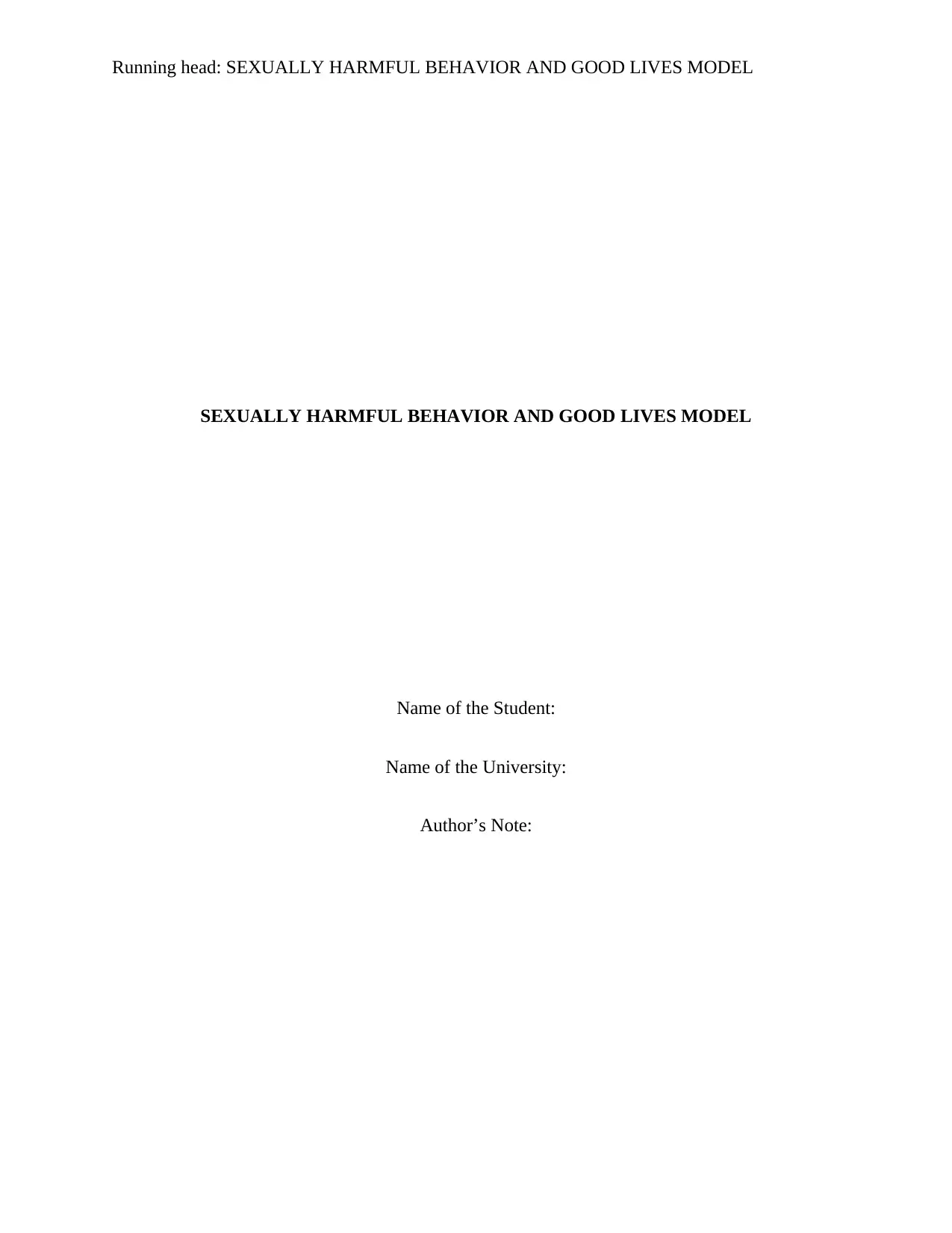
Running head: SEXUALLY HARMFUL BEHAVIOR AND GOOD LIVES MODEL
SEXUALLY HARMFUL BEHAVIOR AND GOOD LIVES MODEL
Name of the Student:
Name of the University:
Author’s Note:
SEXUALLY HARMFUL BEHAVIOR AND GOOD LIVES MODEL
Name of the Student:
Name of the University:
Author’s Note:
Paraphrase This Document
Need a fresh take? Get an instant paraphrase of this document with our AI Paraphraser
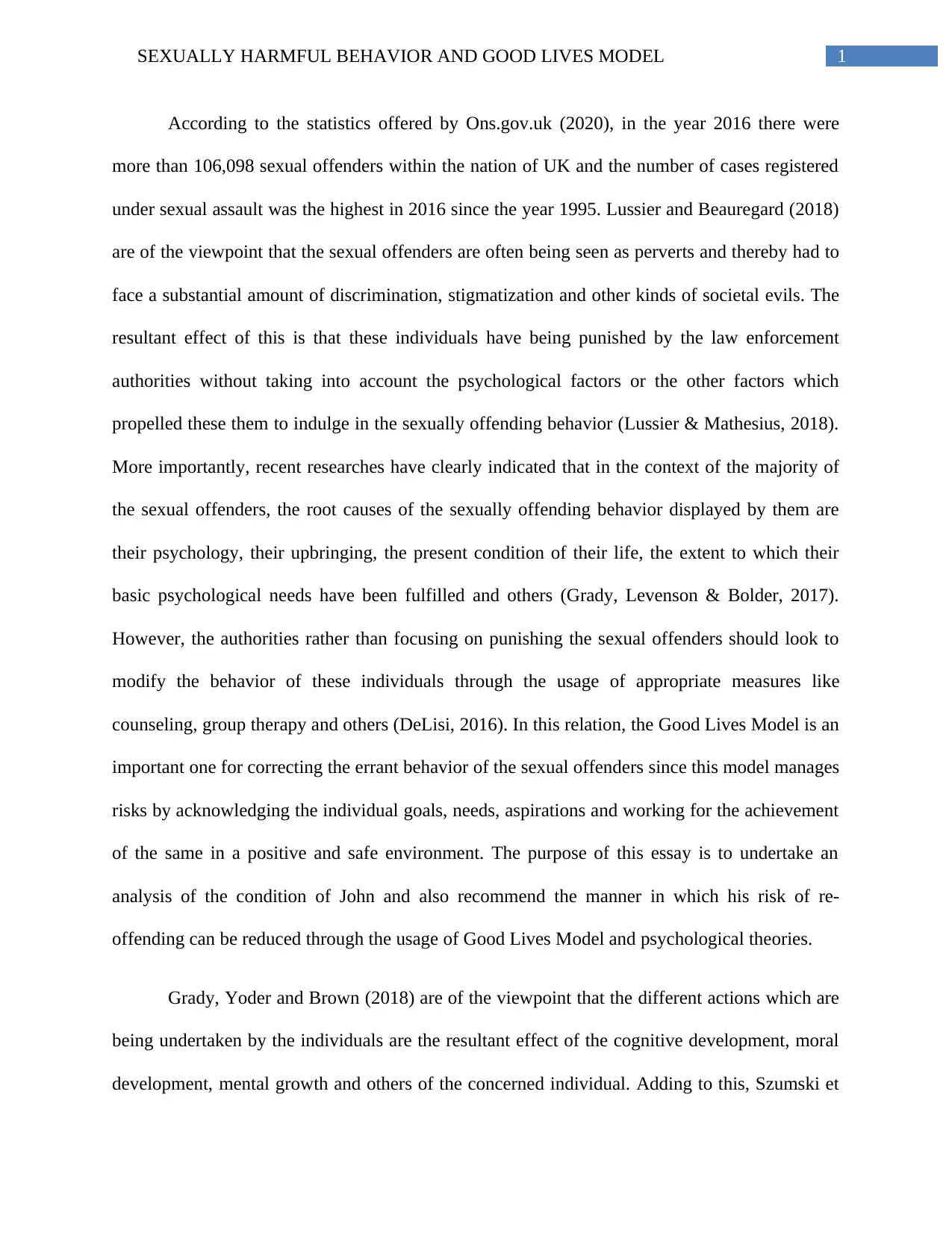
1SEXUALLY HARMFUL BEHAVIOR AND GOOD LIVES MODEL
According to the statistics offered by Ons.gov.uk (2020), in the year 2016 there were
more than 106,098 sexual offenders within the nation of UK and the number of cases registered
under sexual assault was the highest in 2016 since the year 1995. Lussier and Beauregard (2018)
are of the viewpoint that the sexual offenders are often being seen as perverts and thereby had to
face a substantial amount of discrimination, stigmatization and other kinds of societal evils. The
resultant effect of this is that these individuals have being punished by the law enforcement
authorities without taking into account the psychological factors or the other factors which
propelled these them to indulge in the sexually offending behavior (Lussier & Mathesius, 2018).
More importantly, recent researches have clearly indicated that in the context of the majority of
the sexual offenders, the root causes of the sexually offending behavior displayed by them are
their psychology, their upbringing, the present condition of their life, the extent to which their
basic psychological needs have been fulfilled and others (Grady, Levenson & Bolder, 2017).
However, the authorities rather than focusing on punishing the sexual offenders should look to
modify the behavior of these individuals through the usage of appropriate measures like
counseling, group therapy and others (DeLisi, 2016). In this relation, the Good Lives Model is an
important one for correcting the errant behavior of the sexual offenders since this model manages
risks by acknowledging the individual goals, needs, aspirations and working for the achievement
of the same in a positive and safe environment. The purpose of this essay is to undertake an
analysis of the condition of John and also recommend the manner in which his risk of re-
offending can be reduced through the usage of Good Lives Model and psychological theories.
Grady, Yoder and Brown (2018) are of the viewpoint that the different actions which are
being undertaken by the individuals are the resultant effect of the cognitive development, moral
development, mental growth and others of the concerned individual. Adding to this, Szumski et
According to the statistics offered by Ons.gov.uk (2020), in the year 2016 there were
more than 106,098 sexual offenders within the nation of UK and the number of cases registered
under sexual assault was the highest in 2016 since the year 1995. Lussier and Beauregard (2018)
are of the viewpoint that the sexual offenders are often being seen as perverts and thereby had to
face a substantial amount of discrimination, stigmatization and other kinds of societal evils. The
resultant effect of this is that these individuals have being punished by the law enforcement
authorities without taking into account the psychological factors or the other factors which
propelled these them to indulge in the sexually offending behavior (Lussier & Mathesius, 2018).
More importantly, recent researches have clearly indicated that in the context of the majority of
the sexual offenders, the root causes of the sexually offending behavior displayed by them are
their psychology, their upbringing, the present condition of their life, the extent to which their
basic psychological needs have been fulfilled and others (Grady, Levenson & Bolder, 2017).
However, the authorities rather than focusing on punishing the sexual offenders should look to
modify the behavior of these individuals through the usage of appropriate measures like
counseling, group therapy and others (DeLisi, 2016). In this relation, the Good Lives Model is an
important one for correcting the errant behavior of the sexual offenders since this model manages
risks by acknowledging the individual goals, needs, aspirations and working for the achievement
of the same in a positive and safe environment. The purpose of this essay is to undertake an
analysis of the condition of John and also recommend the manner in which his risk of re-
offending can be reduced through the usage of Good Lives Model and psychological theories.
Grady, Yoder and Brown (2018) are of the viewpoint that the different actions which are
being undertaken by the individuals are the resultant effect of the cognitive development, moral
development, mental growth and others of the concerned individual. Adding to this, Szumski et
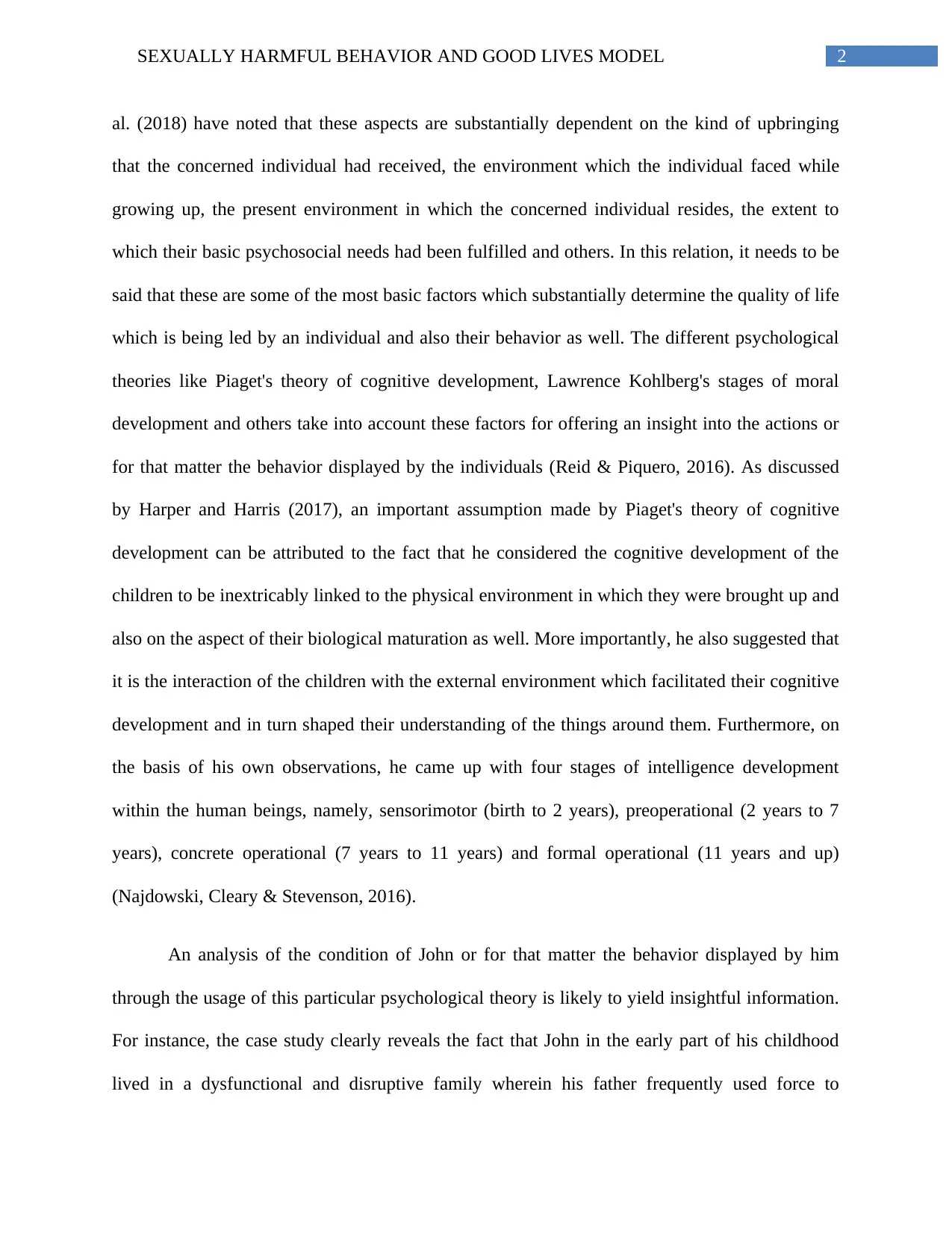
2SEXUALLY HARMFUL BEHAVIOR AND GOOD LIVES MODEL
al. (2018) have noted that these aspects are substantially dependent on the kind of upbringing
that the concerned individual had received, the environment which the individual faced while
growing up, the present environment in which the concerned individual resides, the extent to
which their basic psychosocial needs had been fulfilled and others. In this relation, it needs to be
said that these are some of the most basic factors which substantially determine the quality of life
which is being led by an individual and also their behavior as well. The different psychological
theories like Piaget's theory of cognitive development, Lawrence Kohlberg's stages of moral
development and others take into account these factors for offering an insight into the actions or
for that matter the behavior displayed by the individuals (Reid & Piquero, 2016). As discussed
by Harper and Harris (2017), an important assumption made by Piaget's theory of cognitive
development can be attributed to the fact that he considered the cognitive development of the
children to be inextricably linked to the physical environment in which they were brought up and
also on the aspect of their biological maturation as well. More importantly, he also suggested that
it is the interaction of the children with the external environment which facilitated their cognitive
development and in turn shaped their understanding of the things around them. Furthermore, on
the basis of his own observations, he came up with four stages of intelligence development
within the human beings, namely, sensorimotor (birth to 2 years), preoperational (2 years to 7
years), concrete operational (7 years to 11 years) and formal operational (11 years and up)
(Najdowski, Cleary & Stevenson, 2016).
An analysis of the condition of John or for that matter the behavior displayed by him
through the usage of this particular psychological theory is likely to yield insightful information.
For instance, the case study clearly reveals the fact that John in the early part of his childhood
lived in a dysfunctional and disruptive family wherein his father frequently used force to
al. (2018) have noted that these aspects are substantially dependent on the kind of upbringing
that the concerned individual had received, the environment which the individual faced while
growing up, the present environment in which the concerned individual resides, the extent to
which their basic psychosocial needs had been fulfilled and others. In this relation, it needs to be
said that these are some of the most basic factors which substantially determine the quality of life
which is being led by an individual and also their behavior as well. The different psychological
theories like Piaget's theory of cognitive development, Lawrence Kohlberg's stages of moral
development and others take into account these factors for offering an insight into the actions or
for that matter the behavior displayed by the individuals (Reid & Piquero, 2016). As discussed
by Harper and Harris (2017), an important assumption made by Piaget's theory of cognitive
development can be attributed to the fact that he considered the cognitive development of the
children to be inextricably linked to the physical environment in which they were brought up and
also on the aspect of their biological maturation as well. More importantly, he also suggested that
it is the interaction of the children with the external environment which facilitated their cognitive
development and in turn shaped their understanding of the things around them. Furthermore, on
the basis of his own observations, he came up with four stages of intelligence development
within the human beings, namely, sensorimotor (birth to 2 years), preoperational (2 years to 7
years), concrete operational (7 years to 11 years) and formal operational (11 years and up)
(Najdowski, Cleary & Stevenson, 2016).
An analysis of the condition of John or for that matter the behavior displayed by him
through the usage of this particular psychological theory is likely to yield insightful information.
For instance, the case study clearly reveals the fact that John in the early part of his childhood
lived in a dysfunctional and disruptive family wherein his father frequently used force to
⊘ This is a preview!⊘
Do you want full access?
Subscribe today to unlock all pages.

Trusted by 1+ million students worldwide
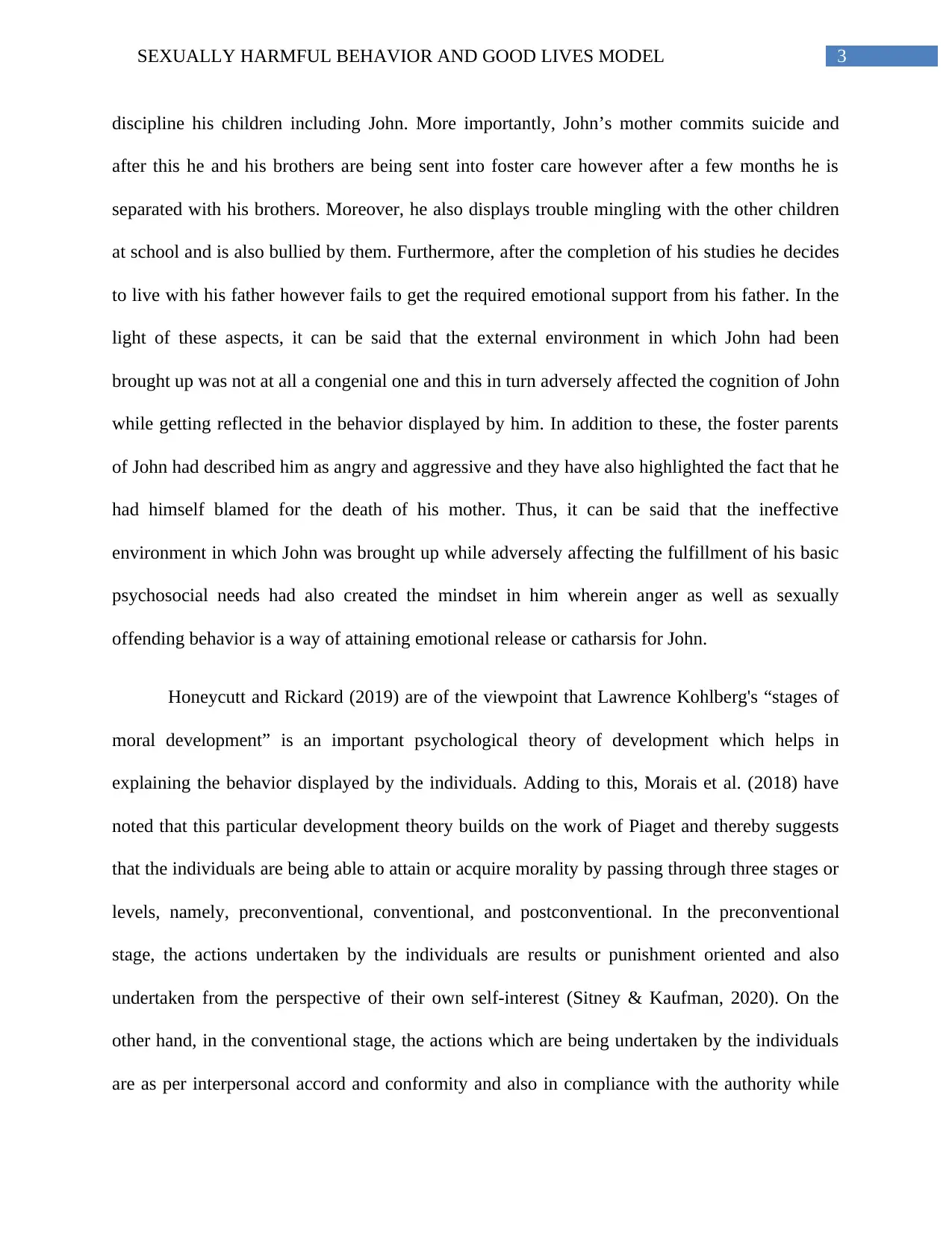
3SEXUALLY HARMFUL BEHAVIOR AND GOOD LIVES MODEL
discipline his children including John. More importantly, John’s mother commits suicide and
after this he and his brothers are being sent into foster care however after a few months he is
separated with his brothers. Moreover, he also displays trouble mingling with the other children
at school and is also bullied by them. Furthermore, after the completion of his studies he decides
to live with his father however fails to get the required emotional support from his father. In the
light of these aspects, it can be said that the external environment in which John had been
brought up was not at all a congenial one and this in turn adversely affected the cognition of John
while getting reflected in the behavior displayed by him. In addition to these, the foster parents
of John had described him as angry and aggressive and they have also highlighted the fact that he
had himself blamed for the death of his mother. Thus, it can be said that the ineffective
environment in which John was brought up while adversely affecting the fulfillment of his basic
psychosocial needs had also created the mindset in him wherein anger as well as sexually
offending behavior is a way of attaining emotional release or catharsis for John.
Honeycutt and Rickard (2019) are of the viewpoint that Lawrence Kohlberg's “stages of
moral development” is an important psychological theory of development which helps in
explaining the behavior displayed by the individuals. Adding to this, Morais et al. (2018) have
noted that this particular development theory builds on the work of Piaget and thereby suggests
that the individuals are being able to attain or acquire morality by passing through three stages or
levels, namely, preconventional, conventional, and postconventional. In the preconventional
stage, the actions undertaken by the individuals are results or punishment oriented and also
undertaken from the perspective of their own self-interest (Sitney & Kaufman, 2020). On the
other hand, in the conventional stage, the actions which are being undertaken by the individuals
are as per interpersonal accord and conformity and also in compliance with the authority while
discipline his children including John. More importantly, John’s mother commits suicide and
after this he and his brothers are being sent into foster care however after a few months he is
separated with his brothers. Moreover, he also displays trouble mingling with the other children
at school and is also bullied by them. Furthermore, after the completion of his studies he decides
to live with his father however fails to get the required emotional support from his father. In the
light of these aspects, it can be said that the external environment in which John had been
brought up was not at all a congenial one and this in turn adversely affected the cognition of John
while getting reflected in the behavior displayed by him. In addition to these, the foster parents
of John had described him as angry and aggressive and they have also highlighted the fact that he
had himself blamed for the death of his mother. Thus, it can be said that the ineffective
environment in which John was brought up while adversely affecting the fulfillment of his basic
psychosocial needs had also created the mindset in him wherein anger as well as sexually
offending behavior is a way of attaining emotional release or catharsis for John.
Honeycutt and Rickard (2019) are of the viewpoint that Lawrence Kohlberg's “stages of
moral development” is an important psychological theory of development which helps in
explaining the behavior displayed by the individuals. Adding to this, Morais et al. (2018) have
noted that this particular development theory builds on the work of Piaget and thereby suggests
that the individuals are being able to attain or acquire morality by passing through three stages or
levels, namely, preconventional, conventional, and postconventional. In the preconventional
stage, the actions undertaken by the individuals are results or punishment oriented and also
undertaken from the perspective of their own self-interest (Sitney & Kaufman, 2020). On the
other hand, in the conventional stage, the actions which are being undertaken by the individuals
are as per interpersonal accord and conformity and also in compliance with the authority while
Paraphrase This Document
Need a fresh take? Get an instant paraphrase of this document with our AI Paraphraser
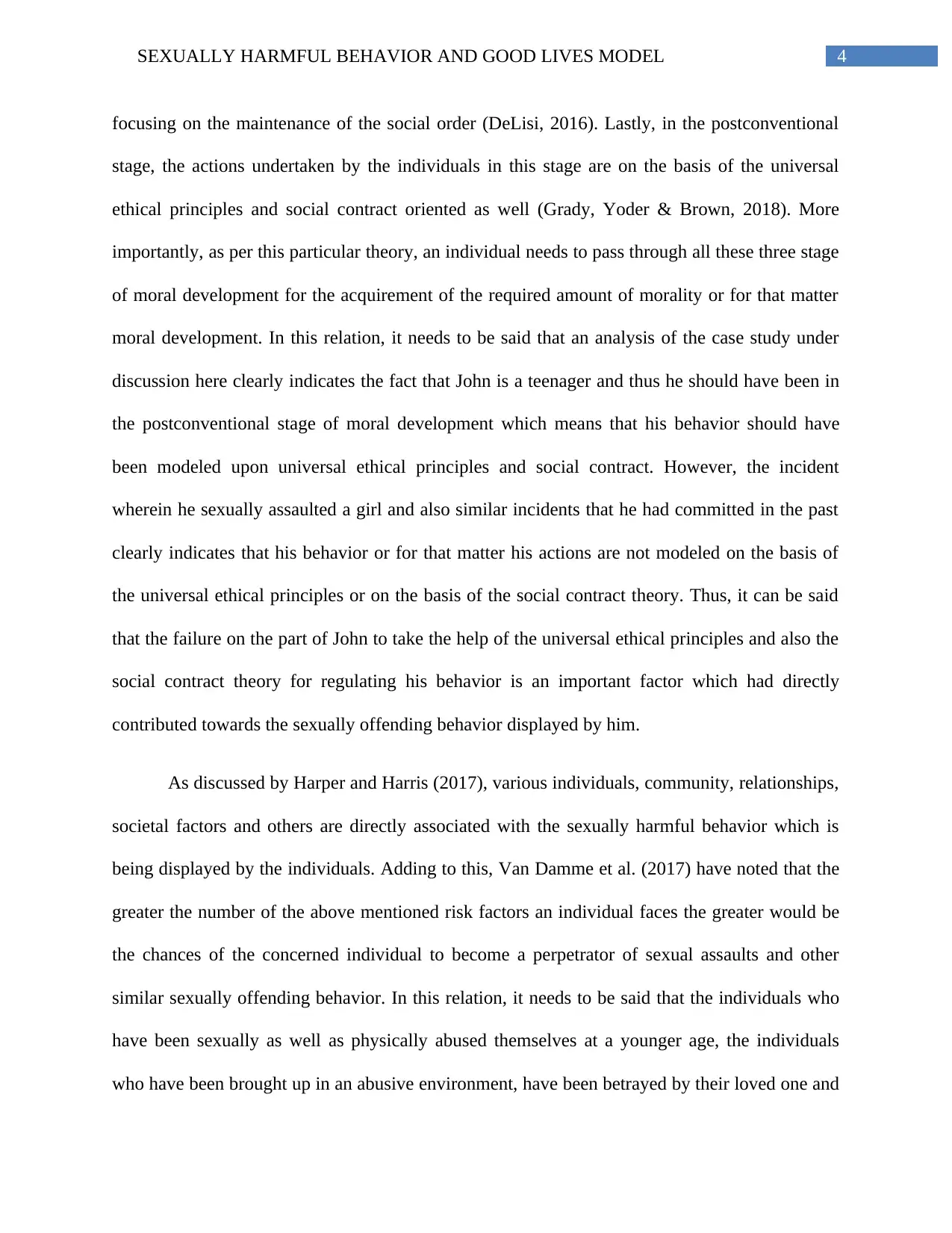
4SEXUALLY HARMFUL BEHAVIOR AND GOOD LIVES MODEL
focusing on the maintenance of the social order (DeLisi, 2016). Lastly, in the postconventional
stage, the actions undertaken by the individuals in this stage are on the basis of the universal
ethical principles and social contract oriented as well (Grady, Yoder & Brown, 2018). More
importantly, as per this particular theory, an individual needs to pass through all these three stage
of moral development for the acquirement of the required amount of morality or for that matter
moral development. In this relation, it needs to be said that an analysis of the case study under
discussion here clearly indicates the fact that John is a teenager and thus he should have been in
the postconventional stage of moral development which means that his behavior should have
been modeled upon universal ethical principles and social contract. However, the incident
wherein he sexually assaulted a girl and also similar incidents that he had committed in the past
clearly indicates that his behavior or for that matter his actions are not modeled on the basis of
the universal ethical principles or on the basis of the social contract theory. Thus, it can be said
that the failure on the part of John to take the help of the universal ethical principles and also the
social contract theory for regulating his behavior is an important factor which had directly
contributed towards the sexually offending behavior displayed by him.
As discussed by Harper and Harris (2017), various individuals, community, relationships,
societal factors and others are directly associated with the sexually harmful behavior which is
being displayed by the individuals. Adding to this, Van Damme et al. (2017) have noted that the
greater the number of the above mentioned risk factors an individual faces the greater would be
the chances of the concerned individual to become a perpetrator of sexual assaults and other
similar sexually offending behavior. In this relation, it needs to be said that the individuals who
have been sexually as well as physically abused themselves at a younger age, the individuals
who have been brought up in an abusive environment, have been betrayed by their loved one and
focusing on the maintenance of the social order (DeLisi, 2016). Lastly, in the postconventional
stage, the actions undertaken by the individuals in this stage are on the basis of the universal
ethical principles and social contract oriented as well (Grady, Yoder & Brown, 2018). More
importantly, as per this particular theory, an individual needs to pass through all these three stage
of moral development for the acquirement of the required amount of morality or for that matter
moral development. In this relation, it needs to be said that an analysis of the case study under
discussion here clearly indicates the fact that John is a teenager and thus he should have been in
the postconventional stage of moral development which means that his behavior should have
been modeled upon universal ethical principles and social contract. However, the incident
wherein he sexually assaulted a girl and also similar incidents that he had committed in the past
clearly indicates that his behavior or for that matter his actions are not modeled on the basis of
the universal ethical principles or on the basis of the social contract theory. Thus, it can be said
that the failure on the part of John to take the help of the universal ethical principles and also the
social contract theory for regulating his behavior is an important factor which had directly
contributed towards the sexually offending behavior displayed by him.
As discussed by Harper and Harris (2017), various individuals, community, relationships,
societal factors and others are directly associated with the sexually harmful behavior which is
being displayed by the individuals. Adding to this, Van Damme et al. (2017) have noted that the
greater the number of the above mentioned risk factors an individual faces the greater would be
the chances of the concerned individual to become a perpetrator of sexual assaults and other
similar sexually offending behavior. In this relation, it needs to be said that the individuals who
have been sexually as well as physically abused themselves at a younger age, the individuals
who have been brought up in an abusive environment, have been betrayed by their loved one and
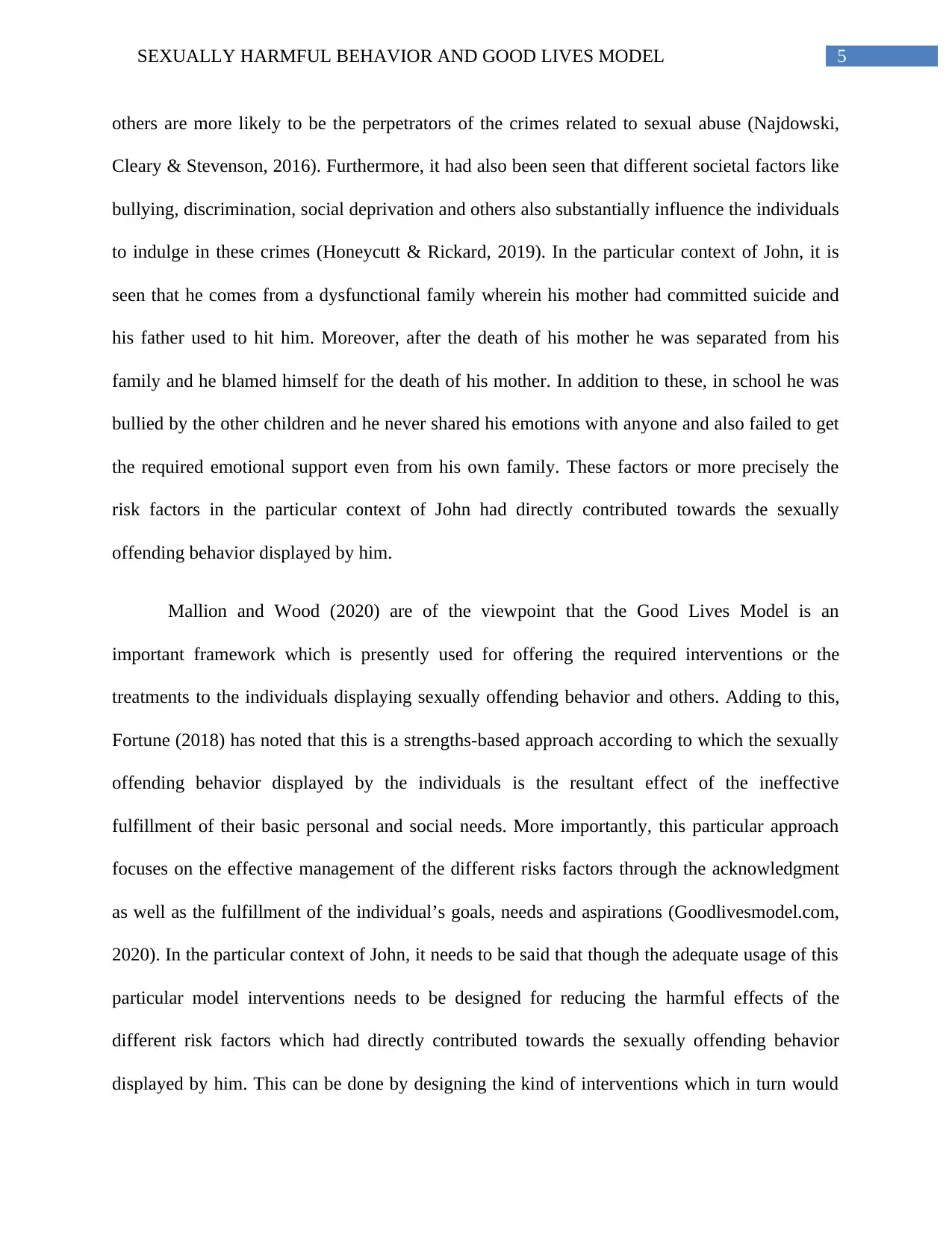
5SEXUALLY HARMFUL BEHAVIOR AND GOOD LIVES MODEL
others are more likely to be the perpetrators of the crimes related to sexual abuse (Najdowski,
Cleary & Stevenson, 2016). Furthermore, it had also been seen that different societal factors like
bullying, discrimination, social deprivation and others also substantially influence the individuals
to indulge in these crimes (Honeycutt & Rickard, 2019). In the particular context of John, it is
seen that he comes from a dysfunctional family wherein his mother had committed suicide and
his father used to hit him. Moreover, after the death of his mother he was separated from his
family and he blamed himself for the death of his mother. In addition to these, in school he was
bullied by the other children and he never shared his emotions with anyone and also failed to get
the required emotional support even from his own family. These factors or more precisely the
risk factors in the particular context of John had directly contributed towards the sexually
offending behavior displayed by him.
Mallion and Wood (2020) are of the viewpoint that the Good Lives Model is an
important framework which is presently used for offering the required interventions or the
treatments to the individuals displaying sexually offending behavior and others. Adding to this,
Fortune (2018) has noted that this is a strengths-based approach according to which the sexually
offending behavior displayed by the individuals is the resultant effect of the ineffective
fulfillment of their basic personal and social needs. More importantly, this particular approach
focuses on the effective management of the different risks factors through the acknowledgment
as well as the fulfillment of the individual’s goals, needs and aspirations (Goodlivesmodel.com,
2020). In the particular context of John, it needs to be said that though the adequate usage of this
particular model interventions needs to be designed for reducing the harmful effects of the
different risk factors which had directly contributed towards the sexually offending behavior
displayed by him. This can be done by designing the kind of interventions which in turn would
others are more likely to be the perpetrators of the crimes related to sexual abuse (Najdowski,
Cleary & Stevenson, 2016). Furthermore, it had also been seen that different societal factors like
bullying, discrimination, social deprivation and others also substantially influence the individuals
to indulge in these crimes (Honeycutt & Rickard, 2019). In the particular context of John, it is
seen that he comes from a dysfunctional family wherein his mother had committed suicide and
his father used to hit him. Moreover, after the death of his mother he was separated from his
family and he blamed himself for the death of his mother. In addition to these, in school he was
bullied by the other children and he never shared his emotions with anyone and also failed to get
the required emotional support even from his own family. These factors or more precisely the
risk factors in the particular context of John had directly contributed towards the sexually
offending behavior displayed by him.
Mallion and Wood (2020) are of the viewpoint that the Good Lives Model is an
important framework which is presently used for offering the required interventions or the
treatments to the individuals displaying sexually offending behavior and others. Adding to this,
Fortune (2018) has noted that this is a strengths-based approach according to which the sexually
offending behavior displayed by the individuals is the resultant effect of the ineffective
fulfillment of their basic personal and social needs. More importantly, this particular approach
focuses on the effective management of the different risks factors through the acknowledgment
as well as the fulfillment of the individual’s goals, needs and aspirations (Goodlivesmodel.com,
2020). In the particular context of John, it needs to be said that though the adequate usage of this
particular model interventions needs to be designed for reducing the harmful effects of the
different risk factors which had directly contributed towards the sexually offending behavior
displayed by him. This can be done by designing the kind of interventions which in turn would
⊘ This is a preview!⊘
Do you want full access?
Subscribe today to unlock all pages.

Trusted by 1+ million students worldwide
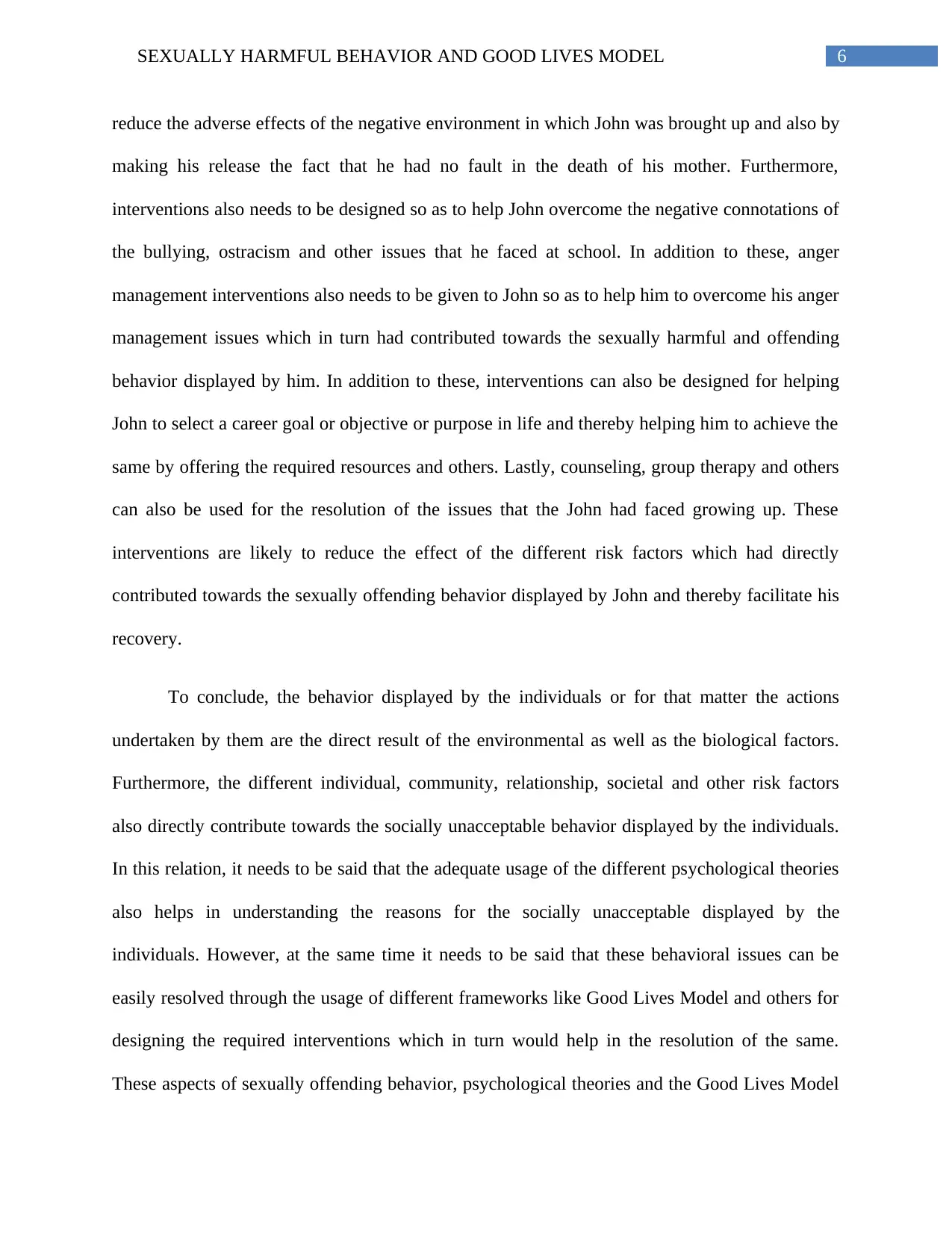
6SEXUALLY HARMFUL BEHAVIOR AND GOOD LIVES MODEL
reduce the adverse effects of the negative environment in which John was brought up and also by
making his release the fact that he had no fault in the death of his mother. Furthermore,
interventions also needs to be designed so as to help John overcome the negative connotations of
the bullying, ostracism and other issues that he faced at school. In addition to these, anger
management interventions also needs to be given to John so as to help him to overcome his anger
management issues which in turn had contributed towards the sexually harmful and offending
behavior displayed by him. In addition to these, interventions can also be designed for helping
John to select a career goal or objective or purpose in life and thereby helping him to achieve the
same by offering the required resources and others. Lastly, counseling, group therapy and others
can also be used for the resolution of the issues that the John had faced growing up. These
interventions are likely to reduce the effect of the different risk factors which had directly
contributed towards the sexually offending behavior displayed by John and thereby facilitate his
recovery.
To conclude, the behavior displayed by the individuals or for that matter the actions
undertaken by them are the direct result of the environmental as well as the biological factors.
Furthermore, the different individual, community, relationship, societal and other risk factors
also directly contribute towards the socially unacceptable behavior displayed by the individuals.
In this relation, it needs to be said that the adequate usage of the different psychological theories
also helps in understanding the reasons for the socially unacceptable displayed by the
individuals. However, at the same time it needs to be said that these behavioral issues can be
easily resolved through the usage of different frameworks like Good Lives Model and others for
designing the required interventions which in turn would help in the resolution of the same.
These aspects of sexually offending behavior, psychological theories and the Good Lives Model
reduce the adverse effects of the negative environment in which John was brought up and also by
making his release the fact that he had no fault in the death of his mother. Furthermore,
interventions also needs to be designed so as to help John overcome the negative connotations of
the bullying, ostracism and other issues that he faced at school. In addition to these, anger
management interventions also needs to be given to John so as to help him to overcome his anger
management issues which in turn had contributed towards the sexually harmful and offending
behavior displayed by him. In addition to these, interventions can also be designed for helping
John to select a career goal or objective or purpose in life and thereby helping him to achieve the
same by offering the required resources and others. Lastly, counseling, group therapy and others
can also be used for the resolution of the issues that the John had faced growing up. These
interventions are likely to reduce the effect of the different risk factors which had directly
contributed towards the sexually offending behavior displayed by John and thereby facilitate his
recovery.
To conclude, the behavior displayed by the individuals or for that matter the actions
undertaken by them are the direct result of the environmental as well as the biological factors.
Furthermore, the different individual, community, relationship, societal and other risk factors
also directly contribute towards the socially unacceptable behavior displayed by the individuals.
In this relation, it needs to be said that the adequate usage of the different psychological theories
also helps in understanding the reasons for the socially unacceptable displayed by the
individuals. However, at the same time it needs to be said that these behavioral issues can be
easily resolved through the usage of different frameworks like Good Lives Model and others for
designing the required interventions which in turn would help in the resolution of the same.
These aspects of sexually offending behavior, psychological theories and the Good Lives Model
Paraphrase This Document
Need a fresh take? Get an instant paraphrase of this document with our AI Paraphraser
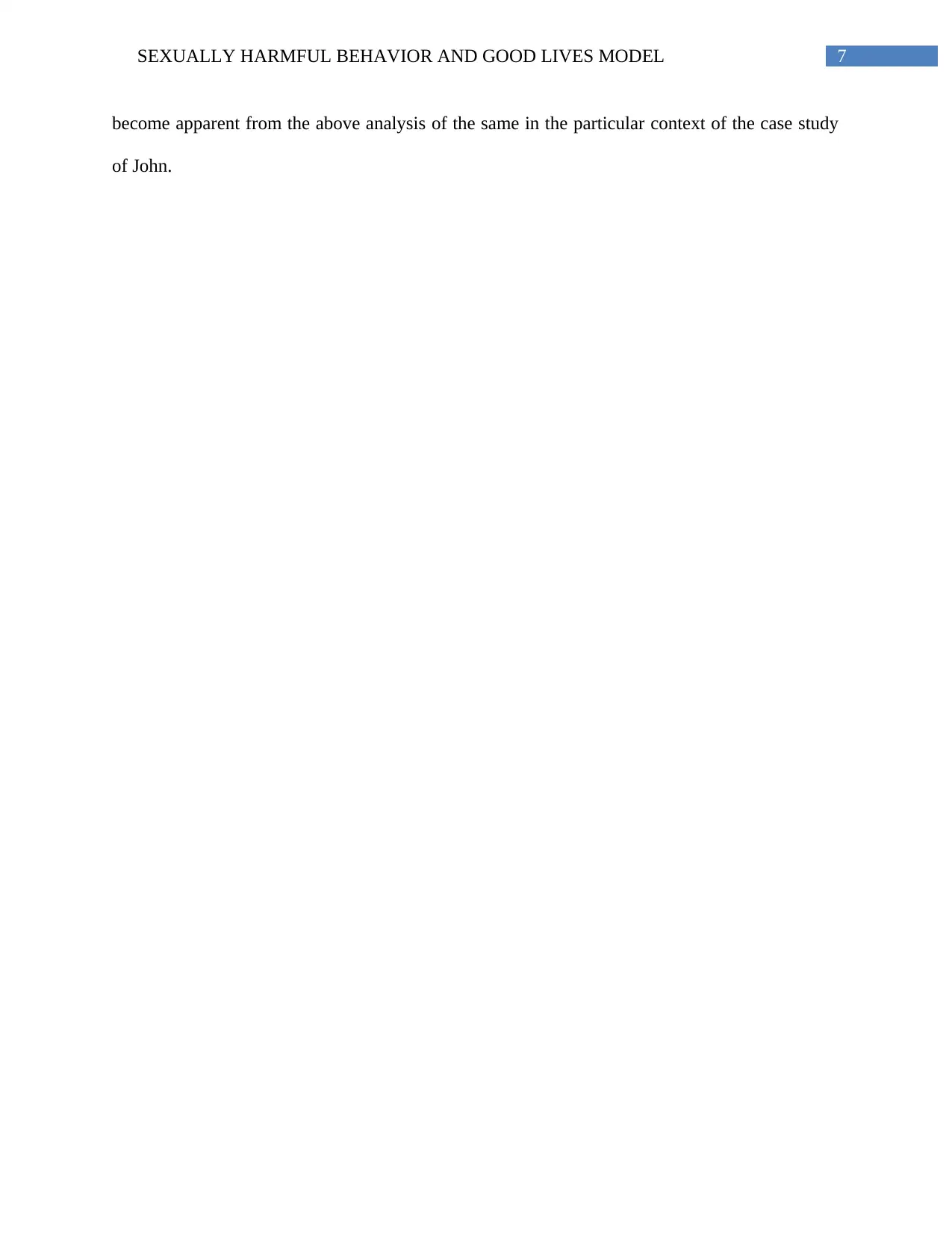
7SEXUALLY HARMFUL BEHAVIOR AND GOOD LIVES MODEL
become apparent from the above analysis of the same in the particular context of the case study
of John.
become apparent from the above analysis of the same in the particular context of the case study
of John.
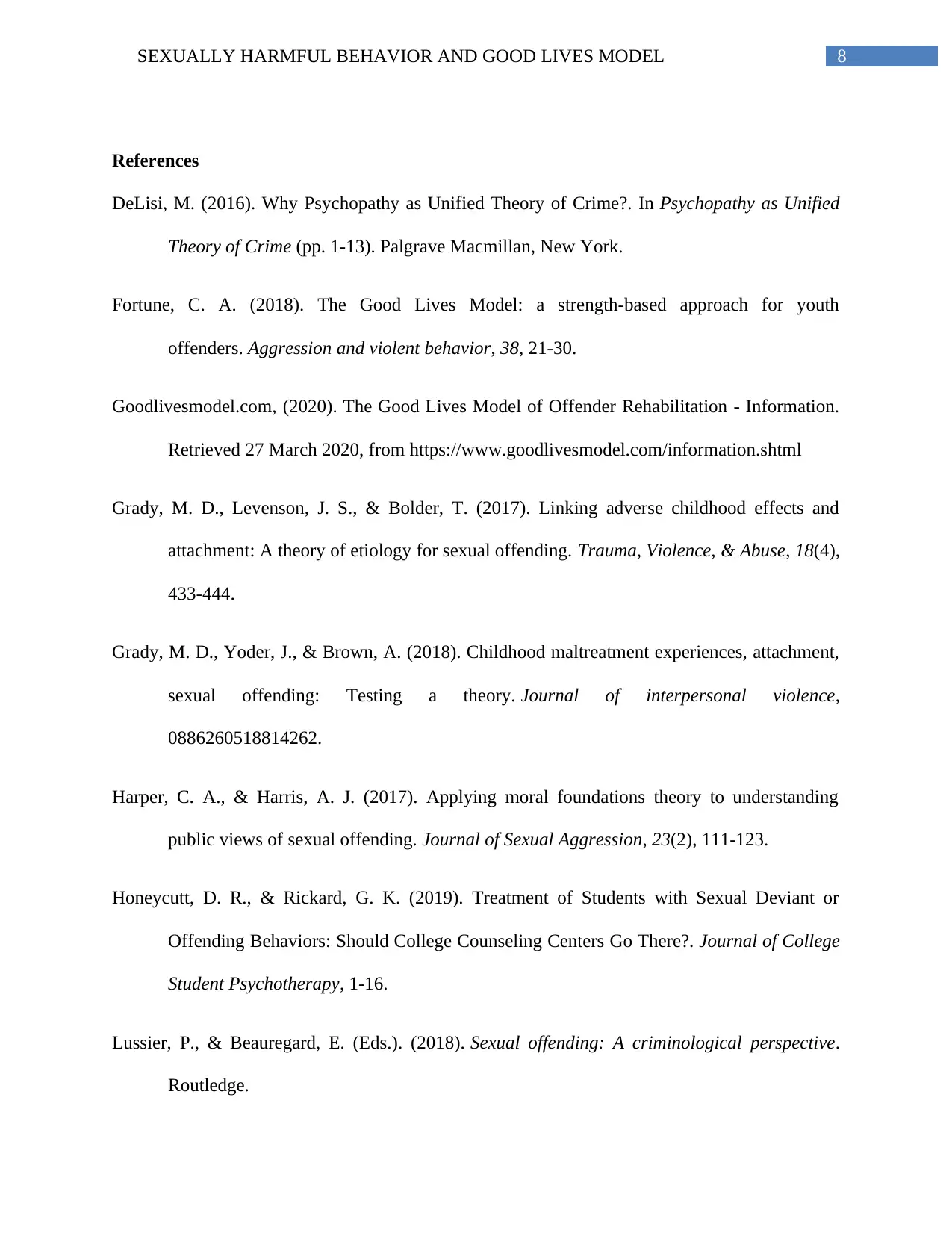
8SEXUALLY HARMFUL BEHAVIOR AND GOOD LIVES MODEL
References
DeLisi, M. (2016). Why Psychopathy as Unified Theory of Crime?. In Psychopathy as Unified
Theory of Crime (pp. 1-13). Palgrave Macmillan, New York.
Fortune, C. A. (2018). The Good Lives Model: a strength-based approach for youth
offenders. Aggression and violent behavior, 38, 21-30.
Goodlivesmodel.com, (2020). The Good Lives Model of Offender Rehabilitation - Information.
Retrieved 27 March 2020, from https://www.goodlivesmodel.com/information.shtml
Grady, M. D., Levenson, J. S., & Bolder, T. (2017). Linking adverse childhood effects and
attachment: A theory of etiology for sexual offending. Trauma, Violence, & Abuse, 18(4),
433-444.
Grady, M. D., Yoder, J., & Brown, A. (2018). Childhood maltreatment experiences, attachment,
sexual offending: Testing a theory. Journal of interpersonal violence,
0886260518814262.
Harper, C. A., & Harris, A. J. (2017). Applying moral foundations theory to understanding
public views of sexual offending. Journal of Sexual Aggression, 23(2), 111-123.
Honeycutt, D. R., & Rickard, G. K. (2019). Treatment of Students with Sexual Deviant or
Offending Behaviors: Should College Counseling Centers Go There?. Journal of College
Student Psychotherapy, 1-16.
Lussier, P., & Beauregard, E. (Eds.). (2018). Sexual offending: A criminological perspective.
Routledge.
References
DeLisi, M. (2016). Why Psychopathy as Unified Theory of Crime?. In Psychopathy as Unified
Theory of Crime (pp. 1-13). Palgrave Macmillan, New York.
Fortune, C. A. (2018). The Good Lives Model: a strength-based approach for youth
offenders. Aggression and violent behavior, 38, 21-30.
Goodlivesmodel.com, (2020). The Good Lives Model of Offender Rehabilitation - Information.
Retrieved 27 March 2020, from https://www.goodlivesmodel.com/information.shtml
Grady, M. D., Levenson, J. S., & Bolder, T. (2017). Linking adverse childhood effects and
attachment: A theory of etiology for sexual offending. Trauma, Violence, & Abuse, 18(4),
433-444.
Grady, M. D., Yoder, J., & Brown, A. (2018). Childhood maltreatment experiences, attachment,
sexual offending: Testing a theory. Journal of interpersonal violence,
0886260518814262.
Harper, C. A., & Harris, A. J. (2017). Applying moral foundations theory to understanding
public views of sexual offending. Journal of Sexual Aggression, 23(2), 111-123.
Honeycutt, D. R., & Rickard, G. K. (2019). Treatment of Students with Sexual Deviant or
Offending Behaviors: Should College Counseling Centers Go There?. Journal of College
Student Psychotherapy, 1-16.
Lussier, P., & Beauregard, E. (Eds.). (2018). Sexual offending: A criminological perspective.
Routledge.
⊘ This is a preview!⊘
Do you want full access?
Subscribe today to unlock all pages.

Trusted by 1+ million students worldwide
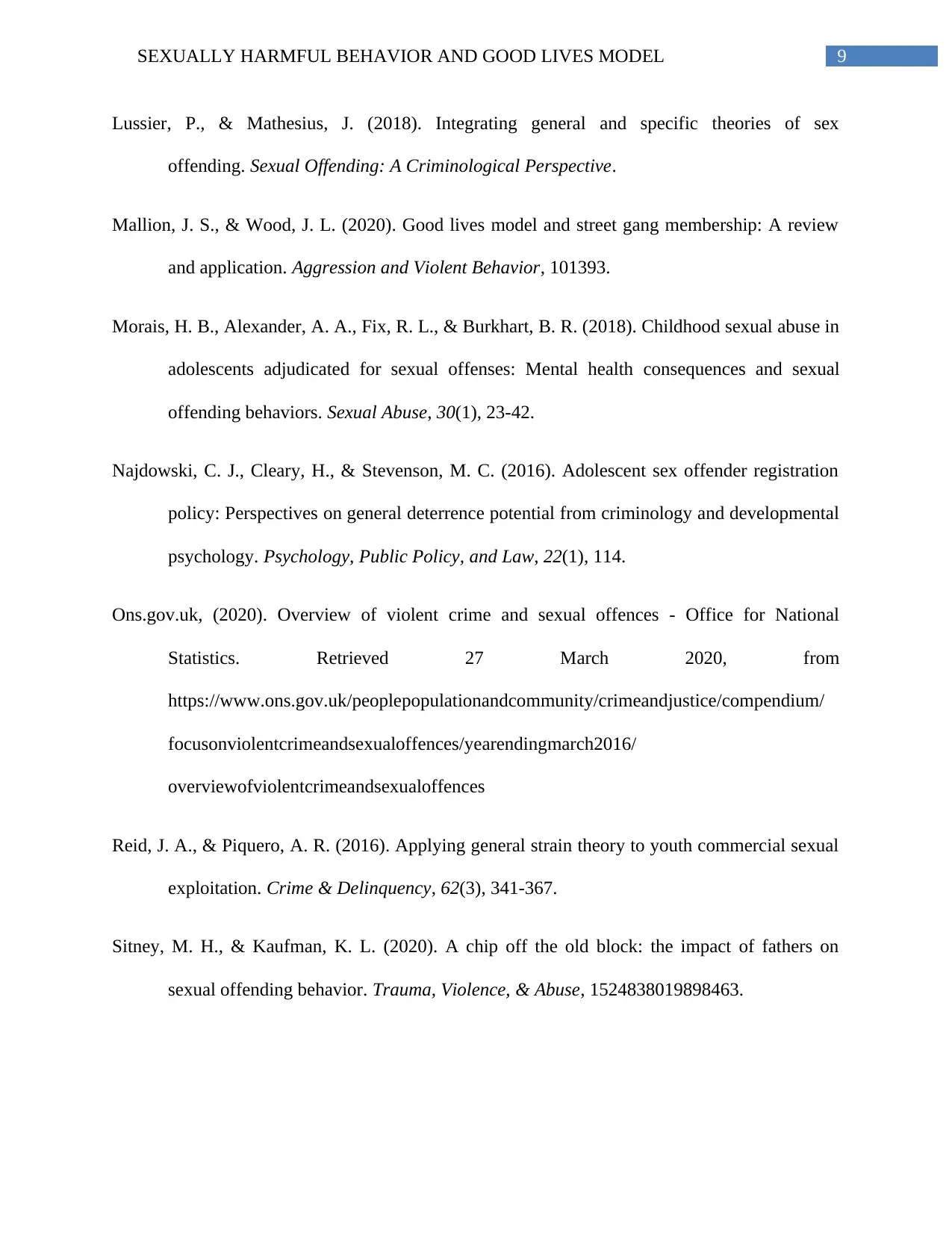
9SEXUALLY HARMFUL BEHAVIOR AND GOOD LIVES MODEL
Lussier, P., & Mathesius, J. (2018). Integrating general and specific theories of sex
offending. Sexual Offending: A Criminological Perspective.
Mallion, J. S., & Wood, J. L. (2020). Good lives model and street gang membership: A review
and application. Aggression and Violent Behavior, 101393.
Morais, H. B., Alexander, A. A., Fix, R. L., & Burkhart, B. R. (2018). Childhood sexual abuse in
adolescents adjudicated for sexual offenses: Mental health consequences and sexual
offending behaviors. Sexual Abuse, 30(1), 23-42.
Najdowski, C. J., Cleary, H., & Stevenson, M. C. (2016). Adolescent sex offender registration
policy: Perspectives on general deterrence potential from criminology and developmental
psychology. Psychology, Public Policy, and Law, 22(1), 114.
Ons.gov.uk, (2020). Overview of violent crime and sexual offences - Office for National
Statistics. Retrieved 27 March 2020, from
https://www.ons.gov.uk/peoplepopulationandcommunity/crimeandjustice/compendium/
focusonviolentcrimeandsexualoffences/yearendingmarch2016/
overviewofviolentcrimeandsexualoffences
Reid, J. A., & Piquero, A. R. (2016). Applying general strain theory to youth commercial sexual
exploitation. Crime & Delinquency, 62(3), 341-367.
Sitney, M. H., & Kaufman, K. L. (2020). A chip off the old block: the impact of fathers on
sexual offending behavior. Trauma, Violence, & Abuse, 1524838019898463.
Lussier, P., & Mathesius, J. (2018). Integrating general and specific theories of sex
offending. Sexual Offending: A Criminological Perspective.
Mallion, J. S., & Wood, J. L. (2020). Good lives model and street gang membership: A review
and application. Aggression and Violent Behavior, 101393.
Morais, H. B., Alexander, A. A., Fix, R. L., & Burkhart, B. R. (2018). Childhood sexual abuse in
adolescents adjudicated for sexual offenses: Mental health consequences and sexual
offending behaviors. Sexual Abuse, 30(1), 23-42.
Najdowski, C. J., Cleary, H., & Stevenson, M. C. (2016). Adolescent sex offender registration
policy: Perspectives on general deterrence potential from criminology and developmental
psychology. Psychology, Public Policy, and Law, 22(1), 114.
Ons.gov.uk, (2020). Overview of violent crime and sexual offences - Office for National
Statistics. Retrieved 27 March 2020, from
https://www.ons.gov.uk/peoplepopulationandcommunity/crimeandjustice/compendium/
focusonviolentcrimeandsexualoffences/yearendingmarch2016/
overviewofviolentcrimeandsexualoffences
Reid, J. A., & Piquero, A. R. (2016). Applying general strain theory to youth commercial sexual
exploitation. Crime & Delinquency, 62(3), 341-367.
Sitney, M. H., & Kaufman, K. L. (2020). A chip off the old block: the impact of fathers on
sexual offending behavior. Trauma, Violence, & Abuse, 1524838019898463.
Paraphrase This Document
Need a fresh take? Get an instant paraphrase of this document with our AI Paraphraser
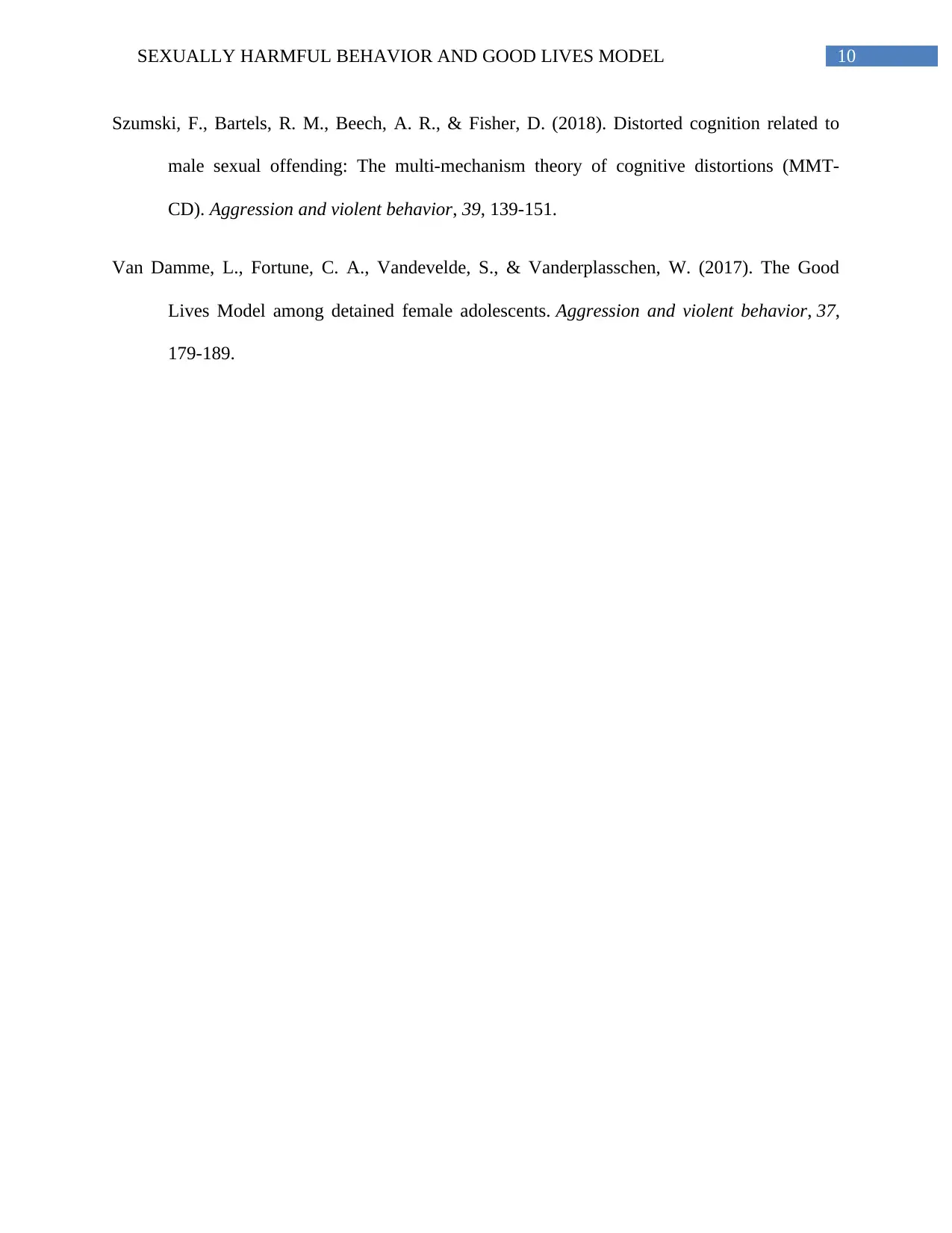
10SEXUALLY HARMFUL BEHAVIOR AND GOOD LIVES MODEL
Szumski, F., Bartels, R. M., Beech, A. R., & Fisher, D. (2018). Distorted cognition related to
male sexual offending: The multi-mechanism theory of cognitive distortions (MMT-
CD). Aggression and violent behavior, 39, 139-151.
Van Damme, L., Fortune, C. A., Vandevelde, S., & Vanderplasschen, W. (2017). The Good
Lives Model among detained female adolescents. Aggression and violent behavior, 37,
179-189.
Szumski, F., Bartels, R. M., Beech, A. R., & Fisher, D. (2018). Distorted cognition related to
male sexual offending: The multi-mechanism theory of cognitive distortions (MMT-
CD). Aggression and violent behavior, 39, 139-151.
Van Damme, L., Fortune, C. A., Vandevelde, S., & Vanderplasschen, W. (2017). The Good
Lives Model among detained female adolescents. Aggression and violent behavior, 37,
179-189.
1 out of 11
Related Documents
Your All-in-One AI-Powered Toolkit for Academic Success.
+13062052269
info@desklib.com
Available 24*7 on WhatsApp / Email
![[object Object]](/_next/static/media/star-bottom.7253800d.svg)
Unlock your academic potential
Copyright © 2020–2025 A2Z Services. All Rights Reserved. Developed and managed by ZUCOL.





